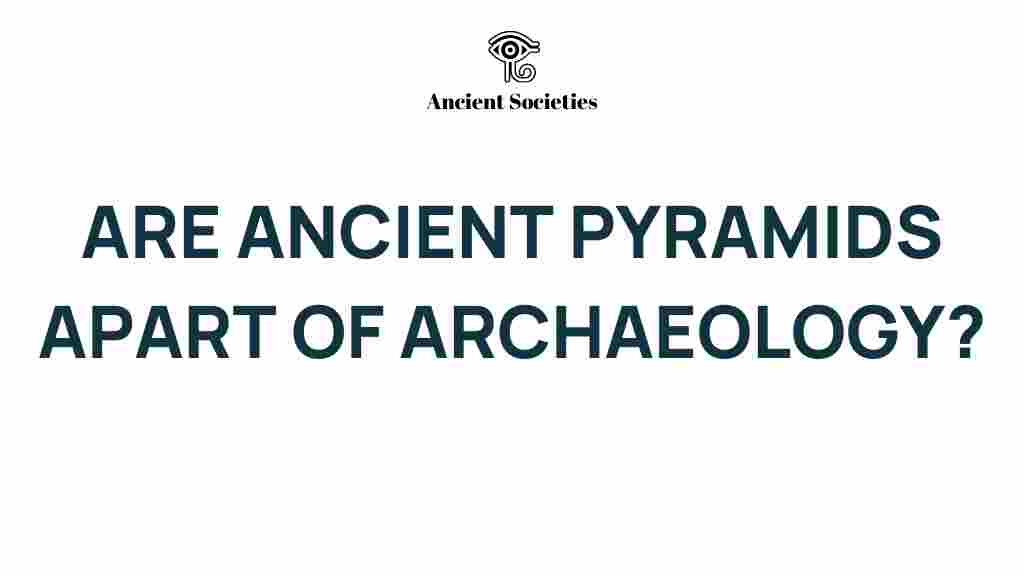Unlocking the Secrets: Are Ancient Pyramids a Key to Archaeology?
The ancient pyramids stand as monumental structures that have fascinated historians, archaeologists, and tourists alike. Their grandeur and mystery hold significant clues about the history, culture, and civilization of ancient Egypt and beyond. In this article, we will explore the importance of ancient pyramids in archaeology, uncovering their secrets and understanding their significance in the broader context of human history.
The Historical Significance of Ancient Pyramids
The ancient pyramids, particularly those in Egypt, are not just architectural wonders; they are also a testament to the civilization that built them. The Great Pyramid of Giza, one of the Seven Wonders of the Ancient World, is a prime example. Here are some key points regarding their historical significance:
- Architectural Marvels: The precision and scale of the construction techniques used to build these pyramids are awe-inspiring. The Great Pyramid was originally 146.6 meters tall and was constructed using approximately 2.3 million blocks of stone.
- Cultural Symbols: Pyramids served as tombs for pharaohs, reflecting the beliefs and practices surrounding death and the afterlife in ancient Egyptian culture.
- Historical Records: Many pyramids contain inscriptions and hieroglyphs that provide insights into the era’s politics, religion, and daily life.
Understanding the Construction of Ancient Pyramids
The construction of ancient pyramids raises several intriguing questions that archaeologists strive to answer. The methodologies and tools used in their construction are still topics of research and debate. Here’s a breakdown of what we know:
- Materials Used: Most pyramids were constructed using limestone, granite, and other local materials. The choice of materials was influenced by the pyramid’s location and the resources available.
- Labor Force: Contrary to popular belief, it is now thought that the pyramids were built by skilled laborers rather than slaves. These workers were likely organized into teams and paid for their labor.
- Construction Techniques: Various theories exist regarding how the massive stones were transported and assembled. Some suggest the use of ramps, while others propose a more complex system of levers and counterweights.
The Role of Ancient Pyramids in Archaeology
Ancient pyramids are crucial to the field of archaeology. They offer a wealth of information that can help us understand past civilizations better. Here’s how they contribute to archaeological research:
- Site Excavations: Excavations around pyramid sites often reveal artifacts, tools, and other structures that provide context about the civilization’s daily life.
- Technological Advances: The study of these structures has led to advancements in archaeological techniques, including the use of ground-penetrating radar and 3D modeling.
- Interdisciplinary Studies: Archaeologists collaborate with historians, geologists, and anthropologists to piece together the complex history surrounding these monumental structures.
Exploring the Mysteries of Ancient Pyramids
Despite extensive research, many mysteries surrounding ancient pyramids remain unsolved. Here are some of the enduring questions that continue to intrigue archaeologists and historians:
- Purpose of Construction: While it is widely accepted that pyramids served as tombs, some theories suggest they had other functions, such as astronomical observatories or symbols of power.
- Alignment with Stars: The precise alignment of pyramids with celestial bodies raises questions about the ancient Egyptians’ understanding of astronomy.
- Hidden Chambers: Recent explorations using modern technology have discovered possible hidden chambers within the pyramids, sparking further investigation into their purpose and contents.
The Cultural Impact of Ancient Pyramids
The pyramids have a lasting impact on culture and art, influencing countless generations. They serve as symbols of ancient Egypt and have been referenced in various forms of media, literature, and art. Here are some aspects of their cultural significance:
- Inspiration for Future Generations: The grandeur of the pyramids continues to inspire architects and builders worldwide.
- Tourism and Economy: The pyramids are a major tourist attraction, contributing significantly to Egypt’s economy through tourism.
- Symbolism in Popular Culture: Ancient pyramids appear in numerous films, books, and games, often as symbols of mystery and ancient wisdom.
Unlocking the Secrets: The Future of Pyramid Exploration
The exploration of ancient pyramids is far from over. As technology advances, new methods for studying these ancient structures emerge, allowing archaeologists to uncover more secrets. Here are some future directions for exploration:
- Advanced Imaging Techniques: Techniques like LiDAR (Light Detection and Ranging) can help identify hidden structures beneath the surface.
- International Collaborations: Archaeological projects are increasingly involving international teams, enhancing the research with diverse expertise.
- Public Engagement: Engaging the public through virtual tours and interactive exhibits can promote interest and funding for further research.
Troubleshooting Common Misconceptions about Ancient Pyramids
As we delve into the mysteries of ancient pyramids, it’s crucial to address some common misconceptions that can mislead public understanding:
- Misconception 1: All pyramids are identical.
In reality, there are various styles and sizes of pyramids across different cultures, including the step pyramid and the true pyramid. - Misconception 2: The pyramids were built by slaves.
Recent evidence suggests that the labor force consisted of skilled workers who were well-fed and housed. - Misconception 3: The pyramids are simply tombs.
While primarily tombs, they also served as symbols of power and religious significance.
Conclusion: The Enduring Legacy of Ancient Pyramids
In conclusion, ancient pyramids are not merely relics of the past; they are keys to understanding the complexities of human history, culture, and civilization. They encapsulate the mysteries of ancient Egypt and remain a focal point for archaeological exploration. As we continue to unlock their secrets, we gain deeper insights into the ancient world and its remarkable achievements.
For more information on ancient pyramids and archaeological discoveries, you can visit the Archaeological Institute of America.
Furthermore, to delve deeper into the cultural significance of ancient civilizations, consider exploring our related article on The Influence of Ancient Cultures on Modern Society.
Ancient pyramids will continue to intrigue and inspire future generations, reminding us of the incredible capabilities and enduring mysteries of human civilization.
This article is in the category Archaeology and created by AncientSocieties Team
